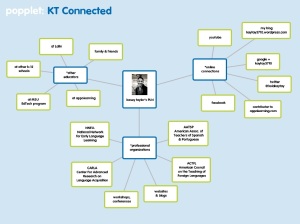Finally! In our EdTech class we arrive at the topic that has long been on my list of things to explore – using technology to manage and increase the efficiency of my workflow. This is also known as GTD, Getting Things Done. From week four of class we learned that David Allen, author of Getting Things Done: The Art of Stress-Free Productivity (2001), suggests that in order to become a more productive and organized individual “you need no new skills to increase your productivity — just a new set of behaviors about when and where to apply them” (p. 80). He even speaks about these new behaviors in a TED Talk YouTube video (http://youtu.be/CHxhjDPKfbY) as ones that will most likely feel “very awkward, very unnatural, and even unnecessary” but that with practice, just like with anything else, these behaviors can become second nature.
We also learned from our online lecture that Allen’s framework for GTD is organized into five stages: collect, process, organize, review, do. I can totally wrap my head around this organization and can quickly identify where I fall short. My weakness is found in the last step, “DO!” I have been a long time master of making lists and organizing to-do’s but sometimes I find myself creating and revising them more than GTD! I really appreciate Allen’s suggestion of not even writing down a to-do item if it only should take you a couple of minutes to complete the task. Unfortunately though, I have a horrible memory. So lots of lists for me are the best option.
So with this information in mind, this week’s assignment was to explore several different productivity tools and share my insights on the usefulness of a favorite tool. For this, I will give a short review of 200 words or less of Evernote.
Evernote Overview:
Are you a constant list maker? Do you have a list for every category of life – home, kids, work, groceries, grad class, etc.? Do you sometimes jot down a list on paper only to then forget where you put it? Well these are all characteristics of my list-making habits, and Evernote has been a life saver.
Evernote Pros:
Wow, Evernote has endless choices for functionality. By far, the biggest organizer for me has been the option to group notes into notebooks. So all the categories listed above get neatly tied up together in a notebook for me to easily reference. There is also a shortcut tab to put quickly access your favorites, a search bar, and a feature to tag notes. For simple word processing purposes, it’s genius! Keep all your docs synced on all devices so you can list away at any given moment. This was unbelievably helpful for grad class while on vacation with my family last week – laptop, iPad, or phone I was GTD with ease. I have not even explored much of the other features such at adding images, audio notes, and FaceTime recordings. And this is not even the premium account which offers more!
Evernote Cons:
Not sure I’ve come across any yet. While there are limitations from a creative standpoint, Evernote gets the job done when it comes to organizing. Give it a try if you are not already a user!
~~~~~~~~~~~~~~~~~~~~~~~~~~~~~~~~~~~~~~~~~~~~~~~~~~~~~~~~~~~~~~~~~~~~~~~~~~
References
Allen, D. (2001). Getting things done: The art of stress-free productivity. New York: Penguin.

